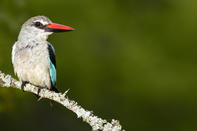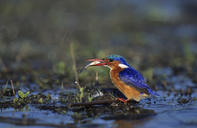Mostly Monogamous
Most species of kingfisher are strictly monogamous (one male and one female pair up). The males defend territories and establish a pair bond with the female through visual displays and courtship feeding.

The Woodland’s kingfisher has a particularly elaborate display, in which it opens its wings and pivoting on a branch displays the white and then the blue side of the wing alternately all the time vocalising loudly. A female taken by his exhibitions will be further convinced to pair up with a male depending on the nuptial gifts he brings her.
Some bird species (including the kingfishers) engage in courtship feeding where the male proves his ability to care for a female and her brood by bringing her morsels of food. This also serves to build up the female’s reserves before she must produce and then incubate for an egg.
While most other species of kingfisher are monogamous, the Pied Kingfisher is the exception to the rule. They practice a form of co-operative breeding and are generally found together in more gregarious groups, nesting in loose colonies.
A particular pair of breeding Pied kingfishers may have a number of helpers, mostly males assisting them with tasks such as feeding and incubation. These may be either offspring from a previous year (called primary helpers) or may, in fact, be totally unrelated to the breeding pair (called secondary helpers). Secondary helpers are permitted to do fewer duties than primary helpers, effectively expending less energy than primary helpers do on the collective breeding effort.
This is because primary helpers are actual kin (and have a genetic investment in seeing the young raised successfully) while secondary helpers assist purely to enhance their chance of breeding in the same place the following season (and potentially with the female in question).
Tunnel Nesters

Most of the kingfishers are tunnel nesters excavating holes into banks on road verges or over rivers. This they do by digging with their bills and then using the bill and wings as props, kick dirt out with their feet. Remarkably, these tunnels penetrate 30 to 60 cm into the hard earth and in the case of the Giant kingfisher up to 1.8 m into the bank. At the end of the tunnel is a small unlined chamber where the eggs are laid.
Keeping tunnel nests clean is problematic and they become progressively fouled throughout the nesting period. The Malachite kingfisher’s nest is a particularly foul establishment with faeces typically leaking down the passage and out of the entrance.
This does have the benefit of putting off predators but adults are often forced to dip-bath in water after leaving the nest to rid themselves of the grime and parasites. The chicks are clothed in spiky quills which are in fact sheaths that protect their feathers from soiling.
Striped and Woodlands kingfishers go against the grain and nest in holes in trees like the disused cavities created by woodpeckers and barbets.
By Megan Emmet